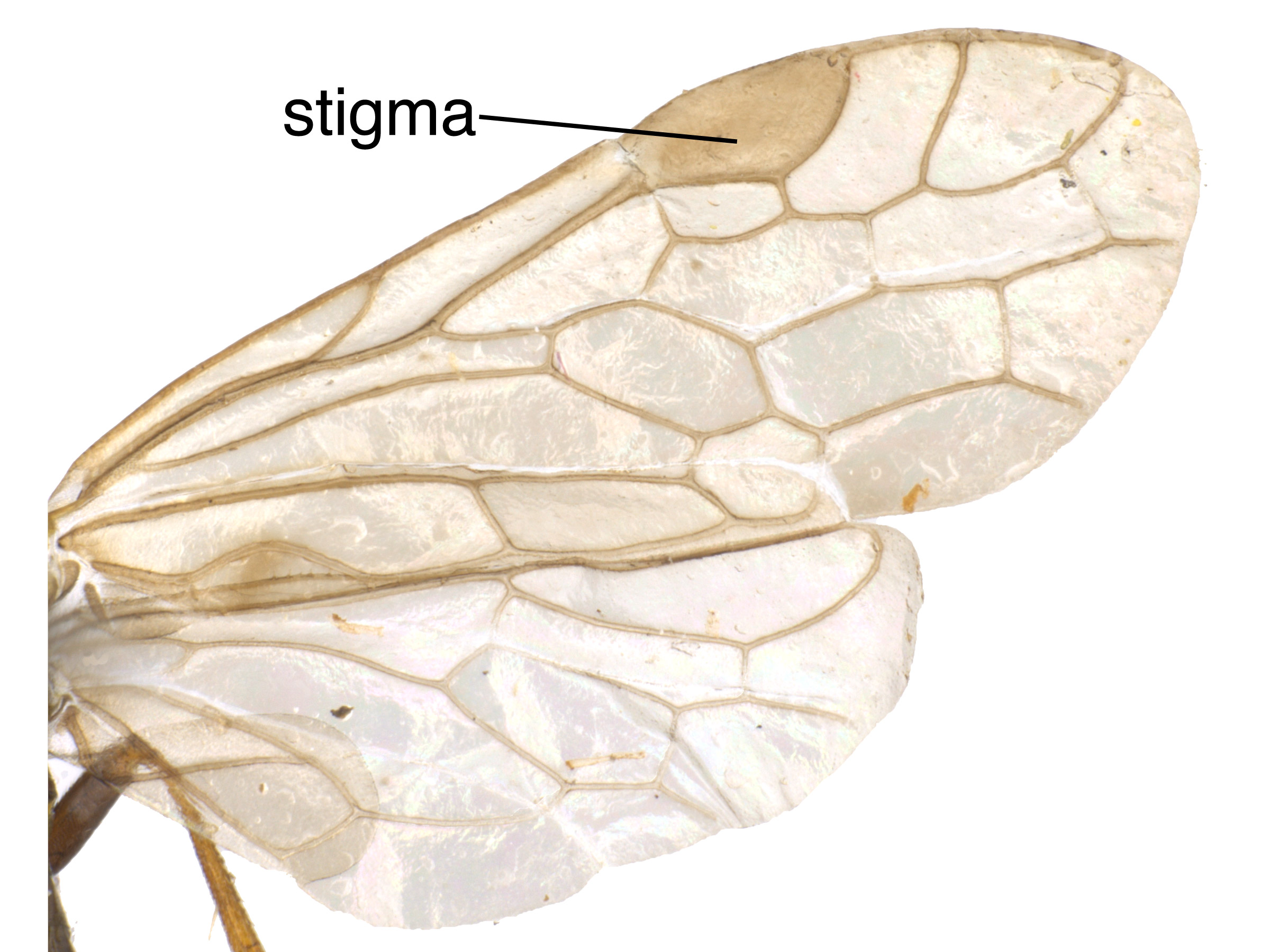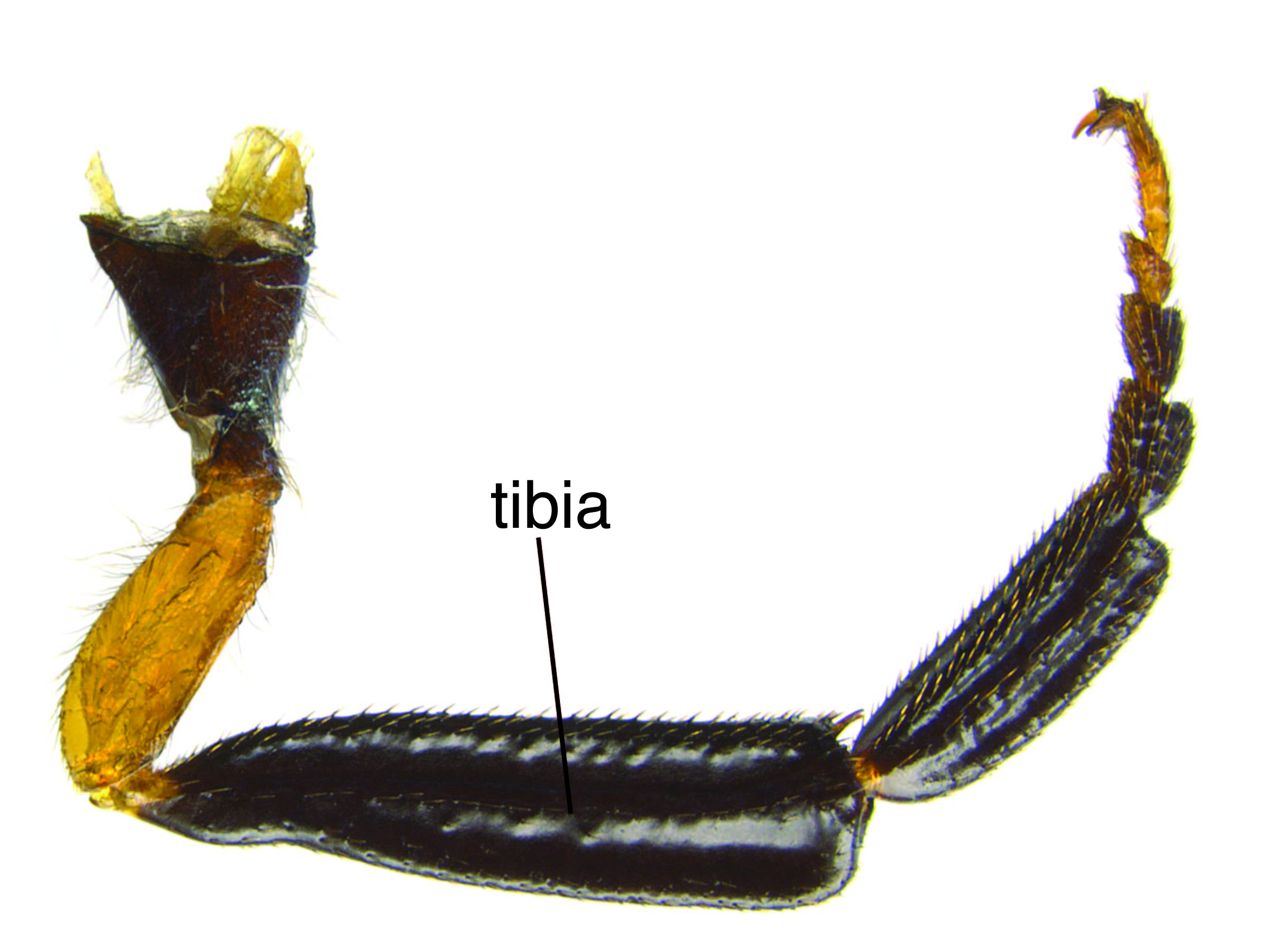Family: Siricidae
Subfamily: Siricinae
Genus: Sirex Linnaeus, 1760
Species: Sirex piceus Xiao and Wu, 1983
Common names: none
Sirex piceus is a rare black species from China (Xiao and Wu 1983Xiao and Wu 1983:
Xiao G and Jian W. 1983. The siricid wood wasps of China (Hymenoptera, Symphyta). Scientia Silvae Sinicae Memoirs of Forest Entomology 8: 1-29.).
See Sirex for genus-level diagnostic characteristics.
Females:
 black with blue-purple metallic reflections (Xiao and Wu 1983Xiao and Wu 1983:
black with blue-purple metallic reflections (Xiao and Wu 1983Xiao and Wu 1983: hyaline with a brown tint near the stigmastigma:
hyaline with a brown tint near the stigmastigma: (Xiao and Wu 1983Xiao and Wu 1983:
(Xiao and Wu 1983Xiao and Wu 1983: and tarsustarsus:
and tarsustarsus: black with light colored band at the apexapex:
black with light colored band at the apexapex:Male S. piceus is not described.
Female S. piceus can be distinguished from similar species S. vates by the yellow-brown tint near the stigmastigma:
a section of the fore wing at the apex of vein C that is sclerotized, rounded and often darkened
 of the fore wingfore wing:
of the fore wingfore wing:
the anterior wing of each pair of wings; usually the largest wing of the pair
 (Xiao and Wu 1983Xiao and Wu 1983:
(Xiao and Wu 1983Xiao and Wu 1983:
Xiao G and Jian W. 1983. The siricid wood wasps of China (Hymenoptera, Symphyta). Scientia Silvae Sinicae Memoirs of Forest Entomology 8: 1-29.).
none recorded
unknown
Female Sirex harbor symbiotic basidiomycete fungus in abdominal glands called mycangia. During oviposition, the site is inoculated with the fungus (Amylostereum spp.), which begins to decompose the surrounding wood. LarvaeLarva:
the immature stage of holometabolous insects
 feed on the fungus, and in the process bore galleries through the wood (Schiff et al. 2012Schiff et al. 2012:
feed on the fungus, and in the process bore galleries through the wood (Schiff et al. 2012Schiff et al. 2012:
Schiff NM, Goulet H, Smith DR, Boudreault C, Wilson AD, and Scheffler BE. 2012. Siricidae (Hymenoptera: Symphyta: Siricoidea) of the Western Hemisphere. Canadian Journal of Arthropod Identification 21: 1-305.).
Larvae are creamy white and grub-like in appearance with a dark head capsule. As with adults, larvaelarva:
the immature stage of holometabolous insects
 possess a short dorsaldorsal:
possess a short dorsaldorsal:
of or on the top surface of the body or structure
horn on the posterior end of the body. The larvaelarva:
the immature stage of holometabolous insects
 bore galleries into wood, feeding until pupation and subsequent emergence. Throughout this process, the larvaelarva:
bore galleries into wood, feeding until pupation and subsequent emergence. Throughout this process, the larvaelarva:
the immature stage of holometabolous insects
 use their horn to pack the tunnel behind them with sawdust. Emergence holes are perfectly circular. The fungal symbiont is carried in specialized organs in female larvaelarva:
use their horn to pack the tunnel behind them with sawdust. Emergence holes are perfectly circular. The fungal symbiont is carried in specialized organs in female larvaelarva:
the immature stage of holometabolous insects
 that develop into the mycangia after metamorphosis (Schiff et al. 2012Schiff et al. 2012:
that develop into the mycangia after metamorphosis (Schiff et al. 2012Schiff et al. 2012:
Schiff NM, Goulet H, Smith DR, Boudreault C, Wilson AD, and Scheffler BE. 2012. Siricidae (Hymenoptera: Symphyta: Siricoidea) of the Western Hemisphere. Canadian Journal of Arthropod Identification 21: 1-305.).
The specific biology of S. piceus is unknown.
World: Sirex piceus is found in central China in the province Qinghai (Xiao and Wu 1983Xiao and Wu 1983:
Xiao G and Jian W. 1983. The siricid wood wasps of China (Hymenoptera, Symphyta). Scientia Silvae Sinicae Memoirs of Forest Entomology 8: 1-29.).
North America: not recorded
Map data from: GBIF.org (26 June 2019) GBIF Occurrence Download Sirex
Details about data used for maps can be found here.